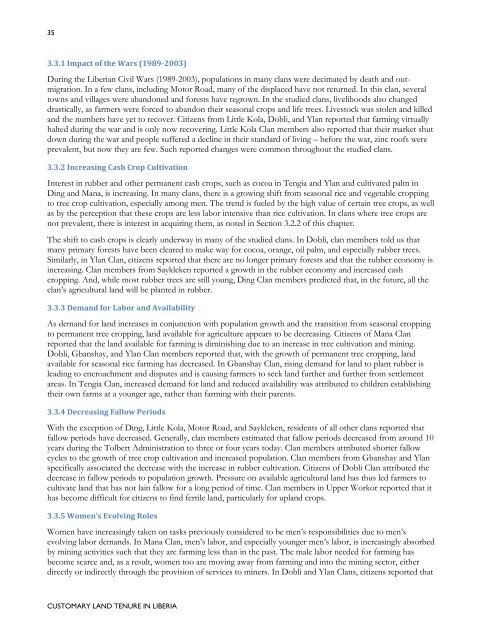Customary Land Tenure in Liberia - Land Tenure and Property ...
Customary Land Tenure in Liberia - Land Tenure and Property ...
Customary Land Tenure in Liberia - Land Tenure and Property ...
You also want an ePaper? Increase the reach of your titles
YUMPU automatically turns print PDFs into web optimized ePapers that Google loves.
35<br />
3.3.1 Impact of the Wars (1989-2003)<br />
Dur<strong>in</strong>g the <strong>Liberia</strong>n Civil Wars (1989-2003), populations <strong>in</strong> many clans were decimated by death <strong>and</strong> outmigration.<br />
In a few clans, <strong>in</strong>clud<strong>in</strong>g Motor Road, many of the displaced have not returned. In this clan, several<br />
towns <strong>and</strong> villages were ab<strong>and</strong>oned <strong>and</strong> forests have regrown. In the studied clans, livelihoods also changed<br />
drastically, as farmers were forced to ab<strong>and</strong>on their seasonal crops <strong>and</strong> life trees. Livestock was stolen <strong>and</strong> killed<br />
<strong>and</strong> the numbers have yet to recover. Citizens from Little Kola, Dobli, <strong>and</strong> Ylan reported that farm<strong>in</strong>g virtually<br />
halted dur<strong>in</strong>g the war <strong>and</strong> is only now recover<strong>in</strong>g. Little Kola Clan members also reported that their market shut<br />
down dur<strong>in</strong>g the war <strong>and</strong> people suffered a decl<strong>in</strong>e <strong>in</strong> their st<strong>and</strong>ard of liv<strong>in</strong>g – before the war, z<strong>in</strong>c roofs were<br />
prevalent, but now they are few. Such reported changes were common throughout the studied clans.<br />
3.3.2 Increas<strong>in</strong>g Cash Crop Cultivation<br />
Interest <strong>in</strong> rubber <strong>and</strong> other permanent cash crops, such as cocoa <strong>in</strong> Tengia <strong>and</strong> Ylan <strong>and</strong> cultivated palm <strong>in</strong><br />
D<strong>in</strong>g <strong>and</strong> Mana, is <strong>in</strong>creas<strong>in</strong>g. In many clans, there is a grow<strong>in</strong>g shift from seasonal rice <strong>and</strong> vegetable cropp<strong>in</strong>g<br />
to tree crop cultivation, especially among men. The trend is fueled by the high value of certa<strong>in</strong> tree crops, as well<br />
as by the perception that these crops are less labor <strong>in</strong>tensive than rice cultivation. In clans where tree crops are<br />
not prevalent, there is <strong>in</strong>terest <strong>in</strong> acquir<strong>in</strong>g them, as noted <strong>in</strong> Section 3.2.2 of this chapter.<br />
The shift to cash crops is clearly underway <strong>in</strong> many of the studied clans. In Dobli, clan members told us that<br />
many primary forests have been cleared to make way for cocoa, orange, oil palm, <strong>and</strong> especially rubber trees.<br />
Similarly, <strong>in</strong> Ylan Clan, citizens reported that there are no longer primary forests <strong>and</strong> that the rubber economy is<br />
<strong>in</strong>creas<strong>in</strong>g. Clan members from Saykleken reported a growth <strong>in</strong> the rubber economy <strong>and</strong> <strong>in</strong>creased cash<br />
cropp<strong>in</strong>g. And, while most rubber trees are still young, D<strong>in</strong>g Clan members predicted that, <strong>in</strong> the future, all the<br />
clan‟s agricultural l<strong>and</strong> will be planted <strong>in</strong> rubber.<br />
3.3.3 Dem<strong>and</strong> for Labor <strong>and</strong> Availability<br />
As dem<strong>and</strong> for l<strong>and</strong> <strong>in</strong>creases <strong>in</strong> conjunction with population growth <strong>and</strong> the transition from seasonal cropp<strong>in</strong>g<br />
to permanent tree cropp<strong>in</strong>g, l<strong>and</strong> available for agriculture appears to be decreas<strong>in</strong>g. Citizens of Mana Clan<br />
reported that the l<strong>and</strong> available for farm<strong>in</strong>g is dim<strong>in</strong>ish<strong>in</strong>g due to an <strong>in</strong>crease <strong>in</strong> tree cultivation <strong>and</strong> m<strong>in</strong><strong>in</strong>g.<br />
Dobli, Gbanshay, <strong>and</strong> Ylan Clan members reported that, with the growth of permanent tree cropp<strong>in</strong>g, l<strong>and</strong><br />
available for seasonal rice farm<strong>in</strong>g has decreased. In Gbanshay Clan, ris<strong>in</strong>g dem<strong>and</strong> for l<strong>and</strong> to plant rubber is<br />
lead<strong>in</strong>g to encroachment <strong>and</strong> disputes <strong>and</strong> is caus<strong>in</strong>g farmers to seek l<strong>and</strong> further <strong>and</strong> further from settlement<br />
areas. In Tengia Clan, <strong>in</strong>creased dem<strong>and</strong> for l<strong>and</strong> <strong>and</strong> reduced availability was attributed to children establish<strong>in</strong>g<br />
their own farms at a younger age, rather than farm<strong>in</strong>g with their parents.<br />
3.3.4 Decreas<strong>in</strong>g Fallow Periods<br />
With the exception of D<strong>in</strong>g, Little Kola, Motor Road, <strong>and</strong> Saykleken, residents of all other clans reported that<br />
fallow periods have decreased. Generally, clan members estimated that fallow periods decreased from around 10<br />
years dur<strong>in</strong>g the Tolbert Adm<strong>in</strong>istration to three or four years today. Clan members attributed shorter fallow<br />
cycles to the growth of tree crop cultivation <strong>and</strong> <strong>in</strong>creased population. Clan members from Gbanshay <strong>and</strong> Ylan<br />
specifically associated the decrease with the <strong>in</strong>crease <strong>in</strong> rubber cultivation. Citizens of Dobli Clan attributed the<br />
decrease <strong>in</strong> fallow periods to population growth. Pressure on available agricultural l<strong>and</strong> has thus led farmers to<br />
cultivate l<strong>and</strong> that has not la<strong>in</strong> fallow for a long period of time. Clan members <strong>in</strong> Upper Workor reported that it<br />
has become difficult for citizens to f<strong>in</strong>d fertile l<strong>and</strong>, particularly for upl<strong>and</strong> crops.<br />
3.3.5 Women’s Evolv<strong>in</strong>g Roles<br />
Women have <strong>in</strong>creas<strong>in</strong>gly taken on tasks previously considered to be men‟s responsibilities due to men‟s<br />
evolv<strong>in</strong>g labor dem<strong>and</strong>s. In Mana Clan, men‟s labor, <strong>and</strong> especially younger men‟s labor, is <strong>in</strong>creas<strong>in</strong>gly absorbed<br />
by m<strong>in</strong><strong>in</strong>g activities such that they are farm<strong>in</strong>g less than <strong>in</strong> the past. The male labor needed for farm<strong>in</strong>g has<br />
become scarce <strong>and</strong>, as a result, women too are mov<strong>in</strong>g away from farm<strong>in</strong>g <strong>and</strong> <strong>in</strong>to the m<strong>in</strong><strong>in</strong>g sector, either<br />
directly or <strong>in</strong>directly through the provision of services to m<strong>in</strong>ers. In Dobli <strong>and</strong> Ylan Clans, citizens reported that<br />
CUSTOMARY LAND TENURE IN LIBERIA

















